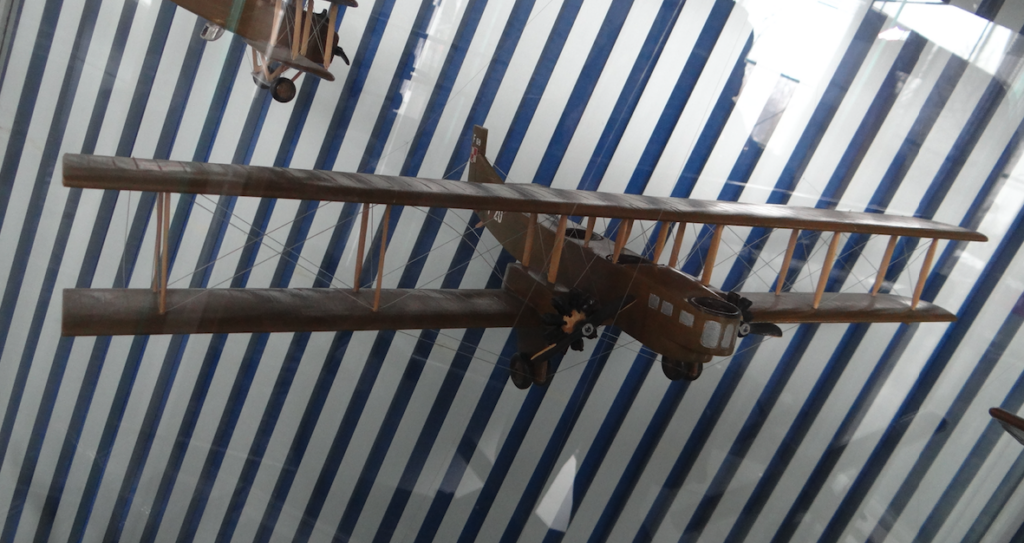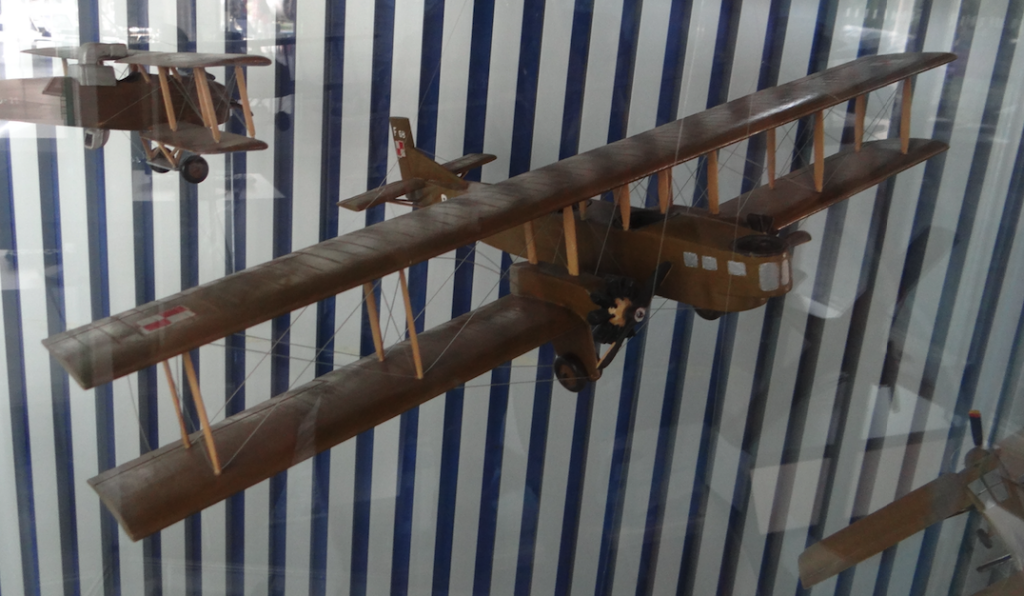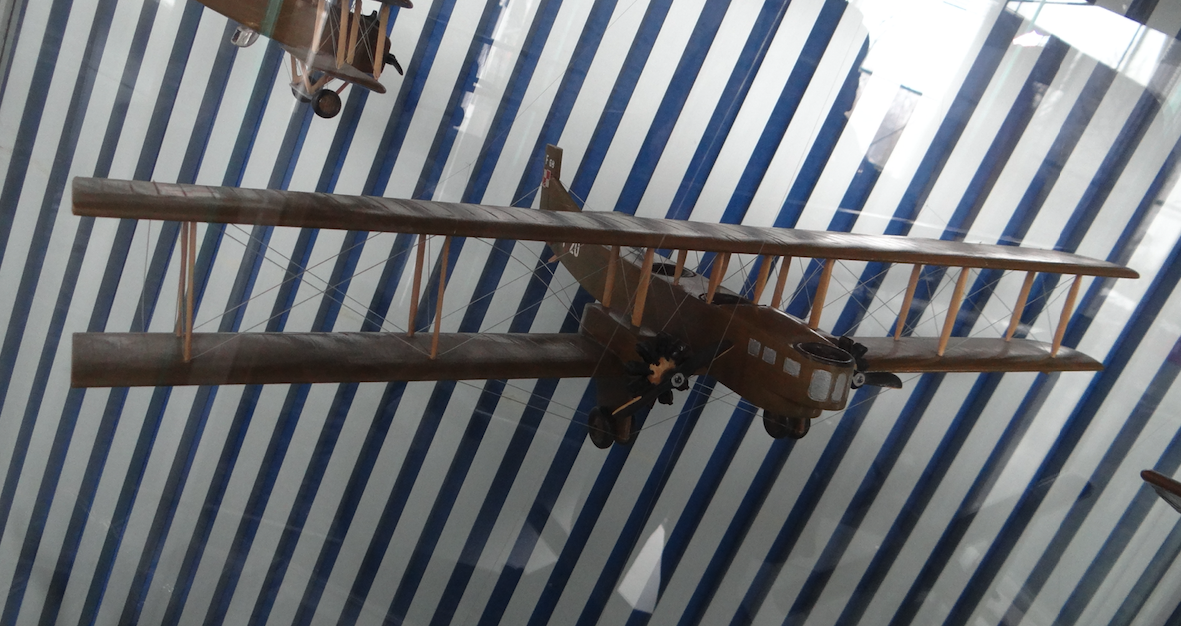Kraków 2017-09-27
Farman F.68 Goliath. 1926
About 60 passenger aircraft were built in various versions and variants. The last aircraft was written off in 1932. In total, about 300 Farman F.60 Goliath aircraft of all versions and variants were built. Farman F.60 aircraft and other variants were used in 11 countries, including Poland. Exotic users at that time included countries such as Japan, Peru and Colombia. Farman F.68 Goliath was the first heavy aircraft used in Poland. Poland bought 32 aircraft. The aircraft was accepted into the equipment of the Polish Army and was used as a bomber, training aircraft, landing aircraft, and also as an agricultural aircraft.


The origins of the French company Avions Farman (Farman Aviation Works) date back to 1907, when Henry Farman and the Voisin brothers built the first aircraft, which after improvements was produced under the name Farman I or Voisin-Farman I. Soon another aircraft was developed, generally designated Farman II. However, the Voisin brothers, behind Henry Farman’s back, sold the aircraft and took it to England. This angered Henry Farman, who definitively broke off cooperation with the Voisin brothers at the beginning of 1909. A family aviation company was already operating since 1908, which was formed by the brothers Henri, Richard (Dick) and Maurice Farman.
The Avions Farman company operated from 1908 to 1941. It built aircraft and engines, and even cars. In 1936, the company was nationalized and assigned to the Société Nationale de Constructions Aéronautiques du Centre (SNCAC) group. In 1941, the Farman brothers reestablished the company as “Société Anonyme des Usines Farman” (SAUF), but three years later it was taken over by Sud-Ouest. Marcel Farman, Maurice’s son, reestablished the SAUF in 1952, but his effort proved unsuccessful and the company was dissolved in 1956. The Farman brothers designed and built over 200 aircraft models between 1908 and 1941.
With the Farman III, Henri Farman and his brothers achieved great success. They founded the Farman Frères company, which at the beginning of the Great War changed its name to Avions Farman (Farman Aviation Works) and began to fulfill orders for the military. At the beginning of 1918, when the Great World War was still going on, the Avions Farman company began to develop and build a gigantic bomber plane for those times. That is why the plane was called Goliath. The project assumed the creation of a heavy bomber capable of carrying 1,000 kg of bombs over a distance of 1,500 km. This meant that the plane was to have a range of up to 3,000 km. Initially, the plane was designated Farman VI, later Farman 6, and finally Farman F-60 with the addition Goliath.
The aircraft was built as a biplane with a classic tail and fixed landing gear. It was planned to use two engines placed between the wings near the fuselage for propulsion. The aircraft’s dimensions inspired respect. You could walk under the lower wing without bending down. The aircraft’s wingspan was 26.50 m, which is why they had to be made in three parts. Almost the entire structure was made of wood. Stiffened with wire rods. Twelve struts between the wings were made of steel tubes profiled with wood. The wing outline was rectangular. The wings were covered with fabric. Ailerons were placed on both the upper and lower wings. The wing profile was constant over the entire span. Three-support landing gear with a tail skid. The main landing gear was built as sets consisting of two wheels on a common axle, with a relatively large diameter. It performed well on the ground fields of the time. The aircraft is simple, solid and light. The length of the aircraft is 14.50 m, span 26.50 m, height 5.0 m, and wing area is 161 square meters.
Three prototypes were built. However, the aircraft’s first flight took place in January 1919, i.e. after the end of the war, and the bomber did not take part in war operations. There were few orders from the military. Therefore, the company decided to develop a version for passenger transport. Such an aircraft could carry 12-14 passengers on board. The cabin was rebuilt, increasing its width and height. Inside, one could stand upright. The interior resembles a railway carriage; the walls and floor are straight, and the ceiling is bulging. Large rectangular windows were installed in the sides and in the front, which allowed passengers to admire the views. Single seats were placed along the sides, on the left and right sides. There were no seats only in place of the entrance doors and at the height of the pilot’s cockpit, where there was a passage to the front part of the fuselage, on the right side. Therefore, the pilot’s seat with controls placed high up was moved slightly to the left. The pilot sat in an open cockpit, with only a windbreak in front of him. Above his head was the upper wing. The passenger seats were either wicker or wooden upholstered, permanently attached to the wooden floor. In some aircraft, something resembling a toilet was arranged in the rear of the fuselage. The aircraft crew consisted of a pilot and a stewardess, whose main task was to provide psychological support to the passengers so that they would not be afraid.
About 60 passenger aircraft were built in various versions and varieties. The last aircraft was written off in 1932. In total, about 300 Farman F.60 Goliath aircraft of all versions and varieties were built. Farman F.60 aircraft and other varieties were used in 11 countries, including Poland. The exotic users at that time included countries such as Japan, Peru and Colombia.
The empty weight of the aircraft was about 2,500 kg, the useful weight was about 2,200 kg, the take-off weight was about 4,700 kg. Maximum speed was about 140 km/h, cruising speed was 110-120 km/h. Range, depending on the version, was 400-500 km. The ceiling was up to 4,000 m, but flights were usually performed at a ceiling of up to 1,000 – 2,000 m, because due to the lack of a hermetic cabin, passengers would not feel comfortable.
The aircraft was powered by various engines. Initially, these were two water-cooled Salmson Z.9 radial engines with a power of 2 x 424 HP (2 x 312 kW) or 2 x 260 HP (2 x 190 kW). Then, customers had a choice of Renault or Lorraine engines.
After the war, the French army bought 210 F-60 Bn.2 aircraft, which were night bombers with a three-person crew and Salmson 9Zm engines, with a power of 260 hp. A variant of the F-60 Torp was also created, designed for torpedo attacks. The aircraft had interchangeable float or wheeled landing gear.
Much more civilian versions were created. There was a variant of the F-60 bis for transporting goods, powered by Salmson 9Az engines, each with a power of 300 hp. The F-62 aircraft was created, intended to win various records, powered by a single 12-cylinder engine in the W system with a power of 500 hp. On August 7, 1925, this aircraft covered a distance of 4,400 km in 45 hours and 12 minutes without landing.
About 20 versions and variants of the Goliath aircraft were created. Most were made in single copies or short series. They differed fundamentally in purpose (bomber, torpedo plane, passenger plane or for transporting goods and mail) and power unit. Wooden two-blade propellers were standard. But four-blade propellers were also used.
First commercial flights.
On February 8, 1919, brothers Henri and Maurice Farman founded an airline, Lignes Aériennes Farman (Farman Airlines), which later became part of Air France. On that day, on the route Paris (Toussus-le-Noble airport) – London (Royal Air Force Station Kenley airport (now Kenley Aerodrome), the first passenger flight of the Farman F-60 Goliath took place. The plane was piloted by Lucien Bossoutrout. There were eleven passengers on board, dressed in military uniforms, because at that time civilians were not allowed to be carried on aircraft in the UK. This regulation was quickly changed. In 1919, various records began to be set on the Farman F-60 Goliath. Especially in terms of load capacity and altitude achieved. On April 1, 1919, the plane climbed to an altitude of 6,200 m, beating the record set in 1916 by 2,200 m. On May 15, 1919, the plane with 26 people on board reached an altitude of 5,100 m. The plane climbed to this altitude for five quarters of an hour, and it took 25 minutes to land.
On August 10-11, 1919, the Goliath flew from Paris to Casablanca in 17 hours and 25 minutes, covering a distance of 2,050 km. During the flight, the plane used 1,300 liters of fuel, and there were still 400 liters left in the tanks. The rally continued, and the route led to Dakar. However, the journey ended with a forced landing due to the loss of a propeller. No one died, and everyone was found by a rescue team after six days. They survived thanks to emergency food rations and fresh water. The plane had a radio communication station on board, but it had a relatively short range.
The F-60 Goliath plane made many forced landings on commercial flights. Usually, the machines were damaged and returned to service after being repaired.
The first major tragedy of the F-60 Goliath was the crash of 7 April 1922. The F.60 Goliath (F-GEAD) while flying in France collided in mid-air with a de Havilland DH.18 (G-EAWO). All seven people on board both aircraft were killed.
On 14 May 1923, an Air Union F.60 Goliath (F-AEBY) crashed in Monsures, France. The cause of the accident was structural failure of the wing. All six people on board were killed. The aircraft was on a scheduled flight from Paris to Croydon.
In total, 14 crashes with fatalities occurred during commercial flights with passengers. According to estimates, about 70 people died. From 1929, F-60 Goliath aircraft only performed cargo and mail flights.
Farman F.68 Goliath in Poland. 1926.
Poland bought a relatively large batch, 32 aircraft designated F-68 BN.4, from a military loan granted to us by France. The aircraft were to enter the armament of a new four-squadron destroyer (bomber) regiment.
The aircraft were powered by Gnome-Rhône 9Aa Jupiter radial engines, with a power of 380 hp each. The aircraft were made in a typical bomber version. The aircraft crew consisted of four pilots.
Data T-T Farman F-68 BN.4: Dimensions wingspan 26.50 m length 14.77 m height 4.90 m. Wing area 154 m2. Empty weight 2,850 kg, take-off weight 5,400 kg. Maximum speed 154 km/h, cruise 120 km/h, ceiling 4,200 m, range 1,200 km. The Farman F-68 BN.4 Goliath aircraft carried 1,040 kg of bombs. It was armed with 5 Lewis machine guns caliber 7.69 mm.
The first Farman F-68BN.4 Goliath aircraft reached Poland in the summer of 1926 and at that time it was already an outdated design. The aircraft was sent to the Institute of Technical Research of Aviation in Warsaw.
During one of the flights, it turned out that one of the engines had stopped working. It almost ended in disaster, because the aircraft was unable to continue flying on one engine, despite its good flight characteristics. The crew would not have been able to choose a suitable place for an emergency landing. The engines turned out to be unreliable and unreliable. It was also assessed that the engines had too little power and were unable to maintain the cruising speed of 130 km/h, declared by the manufacturer. When flying on one engine, the aircraft was unable to maintain the direction of flight and turned in the direction where the engine was not working, despite the rudder being fully deflected.
It also turned out that the impregnated canvas was soaked with rain so much that the aircraft had to take off with a smaller amount of cargo (arms).
As a result, the creation of a bomber regiment was abandoned, and the Farman F-68BN.4 Goliath aircraft were transferred to the training aviation. They began to be based in Dęblin, Grudziądz and Bydgoszcz. They were used to train observers, parachutists and transport cargo. Parachute jumps from the Farman F-68BN.4 Goliath were performed using the breakaway method, which involved the jumper going out onto the wing, opening the parachute and after filling the canopy with air, the parachute pulled the jumper off the wing.
In 1927, the Farman F-68BN.4 Goliath became the first agricultural aircraft in Poland. It was fitted with a dusting device and was intended to be used to combat forest pests. Few flights were made due to the risk of engine failure and the lack of a safe emergency landing.
In 1929, some of the aircraft were transferred to training for the 211th and 212th Night Bomber Squadrons, which began to be equipped with Fokker F.VII/3m aircraft, the production of which began in Lublin, Poland.
Several, probably seven Farman F-68BN.4 Goliath aircraft were sold to Romania. This caused diplomatic tension between Paris and Warsaw due to the conditions of the military loan granted.
The last Farman F-68BN.4 Goliath aircraft was written off from the inventory of the Eaglets School in Dęblin in 1935.
Farman F-68 Goliath construction.
The Farman F-68 Goliath is a bomber aircraft built in a relatively long series for the Polish Army. This was already the period of construction of the last machines. The Farman F-68 Goliath is a twin-engine, biplane aircraft, built in a classic layout. Wooden construction.
The structural wings consist of three sections. They are of wooden construction, covered with plywood and fabric. The wings are stiffened with 12-struts, made of steel tubes, profiled with wood. The wings are additionally reinforced with steel rods. The ailerons are placed on the upper and lower wings. The wing profile is fixed over the entire span.
The fuselage is made as a wooden truss and is covered with plywood. It has a rectangular cross-section. In the front and on the back, two Lewis machine guns are mounted on a turntable. They were operated by gunners. The cockpit located on the back, under the upper wing, is open and has only a windshield. The pilot sat in it. Behind the pilot there was a place for an observer. Behind the wing, on the right side of the fuselage, there is a large rectangular door for the crew and cargo. The relatively large space inside the fuselage and the large entrance door allowed for the transport of larger cargo, parachutists or officer cadets trained as observers. Behind the wing compartment, on the back of the fuselage, there was a position of double-coupled, mobile Lewis machine guns on a turntable, operated by the observer. The fifth, single machine gun of this type, was operated by the bombardier. It fired downwards, through a cutout in the bottom of the fuselage. The bombardier’s sight was mounted on the side of the cabin, outside the aircraft. Bombs were hung on launchers under the fuselage.
The aircraft’s landing gear was classic, with a tail skid. The main landing gear consisted of two profiled legs with shock absorbers and a pair of wheels on a common axle, on each of them.
Propulsion.
The aircraft has two 9-cylinder radial engines Gnome-Rhône Jupiter, placed in nacelles mounted between the wings, at a distance from the fuselage. Two-blade wooden propellers. Fuel tanks in the engine nacelles, with a capacity of 950 liters each and a spare tank in the fuselage with a capacity of 500 liters.
The Farman F-68 Goliath aircraft was equipped with an AD-8P on-board radio station providing communication within a radius of 300-500 km, at an altitude of 2,000 m.
T-T Farman F-68 Goliath data:
Wingspan 26.50 m (86 ft 11 in). Length 14.33 m (47 ft). Height 5.00 m (16 ft 5 in). Wing area 161 sq m (1,730 ft 2). Empty weight 2,500 kg (5,510 lb). Payload weight 3,000 kg (6,610 lb). Landing weight 4,770 kg (10,510 lb). Maximum speed 140 km/h (87 mph). Cruise speed 120 km/h (75 mph). Range 400 km (250 mi). Ceiling 4,000 m (13,100 ft). Powertrain 2 × Salmson Z.9 water-cooled, 312 kW (424 hp) or 260 hp (190 kW) each.
List of aircraft.
In Poland, in 1925, a decision was made to purchase 32 Farman F.68 Goliath bombers for a new bomber unit. The first aircraft were delivered in 1926. The aircraft were used as training machines. Attempts were made to use them as agricultural aircraft for spraying forests for pests. Only a few test flights were made. Several aircraft (probably 7 units) were sold to Romania. The last aircraft was written off from the school in Dęblin in 1935.
Written by Karol Placha Hetman

